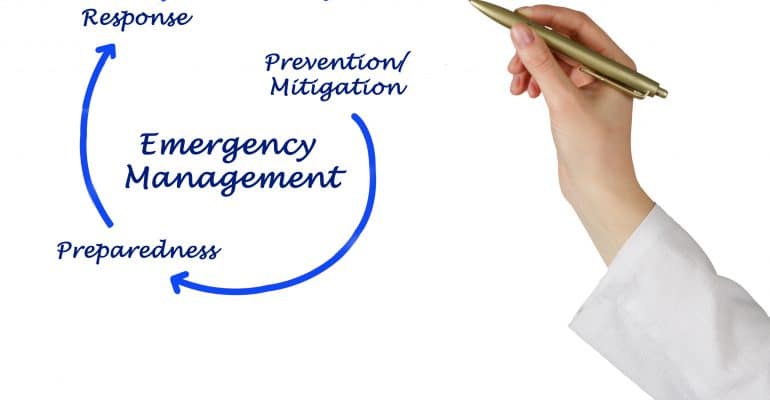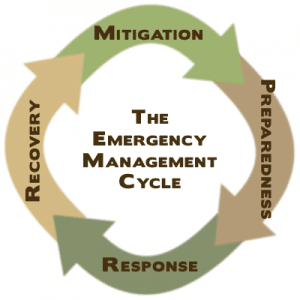“Emergency response and recovery starts locally and with plans/strategies and engagement of all the relevant partners. To the extent that communications were and are good, and pre-existed prior to the disaster, then the success of the various agency responses and mobilization will only be as good as the working relationships are clear, understood and based on mutual respect, [as well as] keeping focused on the bigger picture” — Jay Gsell, county manager, Genesee County, N.Y.
It’s important to recognize the importance of being prepared to handle an emergency or crisis before and after it takes place. Exceptionally trained individuals who have, in many cases, earned a degree in Crisis and Disaster Management, are tasked with preparing communities for these disasters. Lately, we are becoming much too familiar with disasters that call for such action.
We just endured one of the worst hurricane seasons the world has ever seen. The storms have have started to dwindle but the recovery is far from over.
The Atlantic and Caribbean Coasts were struck hard by three massive hurricanes that left thousands of people feeling the intense power and fury that nature beholds.
Storms are becoming more and more intense due to, what scientists speculate as result of, climate change, population growth, global warming and overall warmer temperatures.
This calls for increased precautionary measures to mitigate, prepare, respond and recover from a disaster which is where the four phases of emergency management come into play. But first..
Let’s take a look a closer look at the natural disasters that have recently devastated our nation
Hurricane Harvey
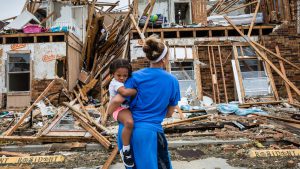
( Image Credit: CNN )
Affected Areas: Texas, Louisiana
Death Toll: 77
Maximum Strength: Category 4, 120 MPH winds
Total Damages: $180 Billion
Hurricane Irma
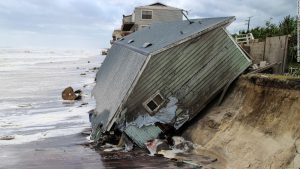
( Image Credit: CNN )
Affected Areas: Florida, Georgia, South Carolina
Death Toll: 61+
Maximum Strength: Category 4, 130 MPH winds
Total Damages: Between $150 Billion – $200 Billion
Hurricane Maria
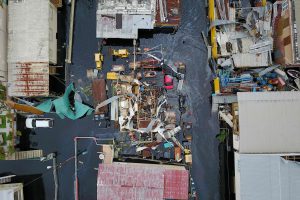
( Image Credit: New York Times )
Affected Areas: Puerto Rico, US Virgin Islands
Death Toll: 45+
Maximum Strength: Category 4, 155 MPH winds
Total Damages: $5-$95 Billion
The Four Phases of Emergency Management
Mitigation
The measures and activities that take place to prevent an emergency from happening or to reduce the potential damage.
Risk analysis provides the necessary data to help establish proper building codes, zoning requirements and barrier construction (ie: flood levees).
The goal of implementing a cost-effective mitigation strategy is to minimize the effects of unavoidable catastrophes.
Preparedness
When an emergency or disaster is likely to ensue, preparedness is used to plan strategies and procedures prior to a crisis taking place. These strategies are designed to save lives and assist with recovery operations.
In the event of an emergency, being prepared with tools, such as having an evacuation strategy or stocking up on food and drink supplies, allows a community to react in a safer and quicker manner.
Rigorous planning, organizing, and training is needed to ensure preparation for an emergency.
Response
Once you successfully prepare for an emergency with strategies and procedures, the “response” phase is when those plans are executed.
The response phase takes place during an emergency and includes operations such as evacuating threatened areas, opening shelters, search and rescue, or firefighting. The goal of response teams is to limit the loss of life and prevent any further property damage.
Recovery
The “Recovery” phase of the four phases of emergency management happens after an emergency or disaster and is designed to help a community return to safe and normal conditions. Recovery actions include debris cleanup, rebuilding of roads or bridges and financial assistance from the government. This is when brave and selfless individuals band together to help one another restore their community to it’s customary state.
21st Century Tools That Help The Emergency Management Phases
Example: Identifying the Problems
In order to develop a plan that is structured best for optimal efficiency in terms of crisis and disaster management, emergency management teams need to first develop a thorough understanding of all the problems they are dealing with. Modern technology and the tools it provides for emergency management is becoming more prioritized.
There are ongoing challenges such as the need to relay information about the disaster as quickly and accurately as possible that requires clear and transparent communication.
Sharing data and information across various organizations is a critical aspect of disaster management as that information is necessary to know which course of action is best to take.
This objective becomes challenging when you factor in harsh weather conditions and combine it with the task of sharing information across multiple platforms and connecting people while having a severe lack of organizational structure.
Utilizing Information and Communication Technology (ICT) can be the difference between life and death in situations such as this.
ICT provides a streamline of information that allows for a more fluid integrated collaboration among organizations. It can lead to a faster reunion of family members who have been separated from their loved ones or prevent damaged property or even the loss of life.
It allows first responders to have an easier time overcoming obstacles that have been created from “distance, diverse languages, cultural differences, geographic barriers, international borders and damaged infrastructure” with effective communication as stated by GovTech.
Three Technologies That Will Assist with The Four Phases of Emergency Management
SimulationDeck –
SimulationDeck helps create realistic scenarios through crisis simulations. It simulates what happens over social media when an emergency or disaster occurs. It helps teams practice real time data analysis and reporting. This benefits the “Preparing” phase of the Emergency Management Model.
Intellistreets –
Intellistreets is an emerging technological breakthrough that will help in the event of an emergency or disaster. For example, Intellistreets lamp posts are designed with “wireless technology to provide emergency alerting, homeland security and public safety functions as well as energy conservation.” These lamp posts are actually able to display evacuation routes safely guiding citizens when it detects rising flood levels. This would benefit the “Response” phase of the emergency management model.
iDawg –
iDawg is a system that is built to connect responders to one another when communication becomes difficult. It creates a direct communication segway that is able to deliver vital information and messages when internet or cell towers are down. An extremely valuable tool that would also benefit the “Response” phase of the emergency management model.
Being prepared and ready to handle any emergency or disaster can easily be the difference between life and death.
Knowing how to manage health during a disaster, being an expert on terrorism and homeland security or being efficient in analyzing and assessing hazards and risks are a few areas that those responsible for managing crises need to know.
These are also a few of the areas that students earning a Bachelor of Science degree in Crisis and Disaster Management at Everglades University will fully master.
There is no such thing as being over-prepared when it comes to dealing with a catastrophe and there is no limit on the amount of knowledge you can acquire towards keeping your community safe. Earning a degree in the respected field, however, is the perfect place to start your journey towards saving lives.



